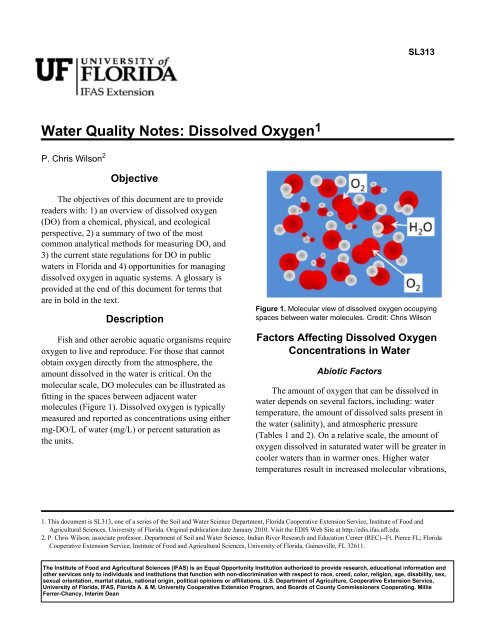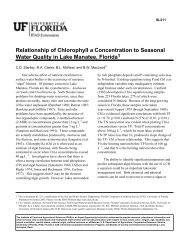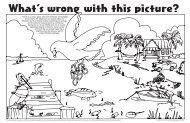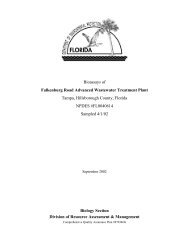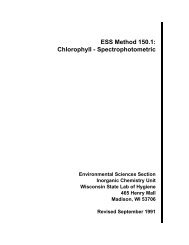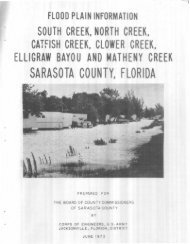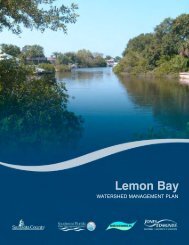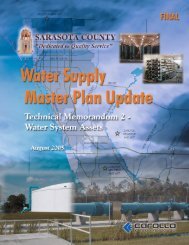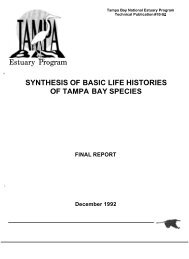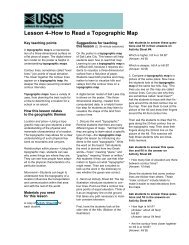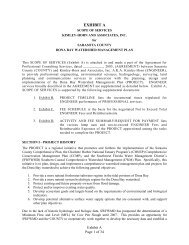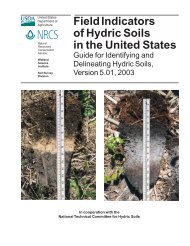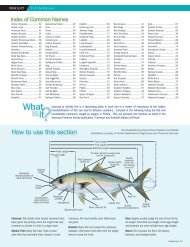Water Quality Notes: Dissolved Oxygen1 - Polk.WaterAtlas.org
Water Quality Notes: Dissolved Oxygen1 - Polk.WaterAtlas.org
Water Quality Notes: Dissolved Oxygen1 - Polk.WaterAtlas.org
Create successful ePaper yourself
Turn your PDF publications into a flip-book with our unique Google optimized e-Paper software.
SL313<strong>Water</strong> <strong>Quality</strong> <strong>Notes</strong>: <strong>Dissolved</strong> Oxygen 1P. Chris Wilson 2ObjectiveThe objectives of this document are to providereaders with: 1) an overview of dissolved oxygen(DO) from a chemical, physical, and ecologicalperspective, 2) a summary of two of the mostcommon analytical methods for measuring DO, and3) the current state regulations for DO in publicwaters in Florida and 4) opportunities for managingdissolved oxygen in aquatic systems. A glossary isprovided at the end of this document for terms thatare in bold in the text.DescriptionFish and other aerobic aquatic <strong>org</strong>anisms requireoxygen to live and reproduce. For those that cannotobtain oxygen directly from the atmosphere, theamount dissolved in the water is critical. On themolecular scale, DO molecules can be illustrated asfitting in the spaces between adjacent watermolecules (Figure 1). <strong>Dissolved</strong> oxygen is typicallymeasured and reported as concentrations using eithermg-DO/L of water (mg/L) or percent saturation asthe units.Figure 1. Molecular view of dissolved oxygen occupyingspaces between water molecules. Credit: Chris WilsonFactors Affecting <strong>Dissolved</strong> OxygenConcentrations in <strong>Water</strong>Abiotic FactorsThe amount of oxygen that can be dissolved inwater depends on several factors, including: watertemperature, the amount of dissolved salts present inthe water (salinity), and atmospheric pressure(Tables 1 and 2). On a relative scale, the amount ofoxygen dissolved in saturated water will be greater incooler waters than in warmer ones. Higher watertemperatures result in increased molecular vibrations,1. This document is SL313, one of a series of the Soil and <strong>Water</strong> Science Department, Florida Cooperative Extension Service, Institute of Food andAgricultural Sciences, University of Florida. Original publication date January 2010. Visit the EDIS Web Site at http://edis.ifas.ufl.edu.2. P. Chris Wilson, associate professor, Department of Soil and <strong>Water</strong> Science, Indian River Research and Education Center (REC)--Ft. Pierce FL; FloridaCooperative Extension Service, Institute of Food and Agricultural Sciences, University of Florida, Gainesville, FL 32611.The Institute of Food and Agricultural Sciences (IFAS) is an Equal Opportunity Institution authorized to provide research, educational information andother services only to individuals and institutions that function with non-discrimination with respect to race, creed, color, religion, age, disability, sex,sexual orientation, marital status, national origin, political opinions or affiliations. U.S. Department of Agriculture, Cooperative Extension Service,University of Florida, IFAS, Florida A. & M. University Cooperative Extension Program, and Boards of County Commissioners Cooperating. MillieFerrer-Chancy, Interim Dean
<strong>Water</strong> <strong>Quality</strong> <strong>Notes</strong>: <strong>Dissolved</strong> Oxygen 3especially important when management activities willincrease the available carbon within a system, such aswith aquatic weed management using aquaticherbicides. The plants killed will become a source ofBOD within the system as they are degraded bymicrobial <strong>org</strong>anisms. Another indirect source of BODto a water body is nutrient runoff from surroundingland and drainage systems. Nutrient enrichment oftenresults in increased algae production, or algaeblooms. Once these algal populations die, BOD willincrease significantly as microbes degrade them.Table 3. Minimum dissolved oxygen concentrations forsustaining life of several aquatic species. LC50 is theconcentration at which 50% of the <strong>org</strong>anisms die. Dataadapted from Avault, Jr. 1996.DOConcentration(mg/L)Organism1-1.1 Juvenile catfish DeathEffect1-2 Catfish Reducedfood intake1.3-1.6 Rainbow trout(6-months old)Death (LC50)1.3-2.5 Rainbow trout(Yearlings)< 3.0 Salmonids Death0.49-1.1 Red Swampcrawfish< 0.7 Brown shrimp(sub-adults)Death (LC50)Death (LC50)DeathAdaptations to Low DO ConditionsFigure 2. <strong>Dissolved</strong> oxygen concentrations are lowest justbefore the sun rises and highest when photosynthesisrates are the greatest (i.e. the sun is closest to thephotosynthesizing <strong>org</strong>anisms). Credit: Chris WilsonConsequences of Low DOConcentrationsDO requirements for maintenance of health andreproduction differ for different fish and invertebratespecies. Prolonged exposure to low DO levels maynot directly kill an <strong>org</strong>anism, but may significantlyincrease its susceptibility to other environmentalstresses and diseases. Most data related to low DOtolerance is available from the aquaculture industry;less data are available for natural systems. Exposureto less than 2 mg/L oxygen for one to four days maykill most of the biota in a system, leaving behindlow-DO tolerant fish, air-breathing insects andanaerobic (not requiring oxygen) bacteria and fungi(microflora). Table 3 lists reported lethal minimumDO concentrations for several species common to thenatural environment and the aquaculture industry.Generally, the lethal DO concentrations for fish arebetween 1 and 3 mg/L. At these levels, fish activity isminimal. For normal levels of activity, DOconcentrations above 3 mg/L generally seemsufficient for many species.The presence of aquatic <strong>org</strong>anisms in a givenwater body may not be indicative of DOconcentrations that are adequate for all aquatic life.Many aquatic <strong>org</strong>anisms (vertebrates andinvertebrates) require different amounts of DO fornormal respiration. Survival of these <strong>org</strong>anismsdecreases when DO concentrations are depressedlower than <strong>org</strong>anism-specific critical levels forextended periods of time. However, thisgeneralization does not hold for all aquatic <strong>org</strong>anisms.Some fish species such as gar and bowfin can live inlow DO environments by breathing at the surface.Other species such as the mosquito fish haveupward-pointing mouths that are well adapted toobtain oxygen from the air-water interface. Inaddition, many fish species can physiologicallyacclimate to low DO conditions by increasing theamount of water flowing over their gills, loweringmetabolic oxygen demand, and by increasinghemoglobin (oxygen-carrying component of blood)and hematocrit levels. With the exception ofincreasing gill activity, these adaptations generallyrequire long-term exposure to low, sublethal DOlevels. Aside from the obvious presence of dead fish,one of the most common symptoms of low DOwithin a system before a fish kill occurs is thepresence of fish gulping for air at the water surface.
<strong>Water</strong> <strong>Quality</strong> <strong>Notes</strong>: <strong>Dissolved</strong> Oxygen 4Aquatic invertebrates also differ widely in whereand how they obtain oxygen. Table 4 lists severalcommon orders of aquatic insects and their sources ofoxygen and respiratory options. Some aquatic insectsare capable of obtaining oxygen directly from theatmosphere or from plants. <strong>Dissolved</strong> oxygenconcentrations in water are of little consequence tothese <strong>org</strong>anisms. Others have cutaneous respiratorysystems, gills, or hemoglobin that transfers dissolvedoxygen from the water column into their bodies forrespiration. The amount of oxygen dissolved in thewater is important for these species. In addition,these <strong>org</strong>anisms vary in their abilities to adapt to- andin their tolerance of- low DO conditions. Many of thesediment dwelling chironomid larvae andpolycheate/oligocheate worms are commonly foundin areas with very low DO concentrations.Table 4. Several common orders of aquatic insects and theirmodes of obtaining- and sources of- oxygen for respiration.OrderDipteraColeopteraHemipteraColeopteraDipteraColeopteraDipteraLepidopteraColeopteraDipteraEphemeropteraOdonataPlecoptera,LepidopteraMegalopteraNeuropteraTricopteraRespiratoryOptionAtmosphericbreathers.Spiacles in contactwith theatmospherecontinuously orperiodically.Plant breathers.Spiracles modifiedto piercesubmergedportions ofaerenchymatissue in wetlandplants.Use air-storage<strong>org</strong>ans. This istypically a gasbubble that istransported withthe <strong>org</strong>anism.Breathe throughgills, physicalstructures thatfacilitate O2transfer from thewater.OxygenSourceAtmospherePlantsAtmosphereor dissolved<strong>Dissolved</strong>oxygenTable 4. Several common orders of aquatic insects and theirmodes of obtaining- and sources of- oxygen for respiration.OrderDipteraLepidopteraPlecopteraTricopteraHemipteraDipteraRespiratoryOptionDiffusion of O2through thecuticle. Becauseof respirationneeds, onlypractical for<strong>org</strong>anisms with ahigh surface areato volume ratio.Hemoglobin.Specialized formof hemoglobin thatreleases O2at lowexternal O2pressures, suchas found in lowDO waters andmud.OxygenSource<strong>Dissolved</strong>Atmosphereor dissolvedMeasurement Timing and Methods<strong>Dissolved</strong> oxygen measurements are especiallyuseful when fish kills are first detected, or when fishare seen gulping for air at the water surface. Timelymeasurements of this type are often indispensible indetermining the cause of death (i.e. lack of DOversus poisoning, etc.). In addition to helping definecause and effect associated with fish kills, monitoringof DO is often necessary for managing aquaticsystems for their intended use. <strong>Dissolved</strong> oxygenconcentrations taken at sporatic intervals of time aredifficult to interpret due to the diurnal oxygen cycle.For this reason, a DO monitoring program should betailored for individual needs. Since the lowest DOlevels typically influence what species can live in agiven waterbody, one might be interested indetermining the lowest DO concentrations over aspan of time by taking measurements before dawnevery morning or over a series of mornings.Conversely, taking samples throughout the day willgive an idea of the daily fluctuations in DOconcentrations (minimum, maximum, mean,median), which are related to photosynthetic activity,respiration, and atmospheric transfer of oxygen.Measurements taken in the early afternoon will likelyrepresent the highest achievable DO concentrations in
<strong>Water</strong> <strong>Quality</strong> <strong>Notes</strong>: <strong>Dissolved</strong> Oxygen 5a given water body with regard to photosynthetic<strong>org</strong>anisms.<strong>Dissolved</strong> oxygen can be measured by twocommon techniques, each with advantages anddisadvantages. The first method is called aniodometric method or Winkler titration and thesecond method uses a gas-permeable membraneelectrode. These methods are discussed in thefollowing sections.Iodometric MethodThe description of this method was taken fromStandard Methods for Examination of <strong>Water</strong> andWastewater (APHA et. al, 1995) . This referenceshould be consulted for more detailed informationwhen needed. The iodometric method can be one ofthe most precise and reliable procedures for DOanalysis. This is a titration-based method based onthe reaction of DO with divalent manganese (Mn ++ )ions. Briefly, after adding a known amount ofdissolved divalent manganese ions and iodide to aknown volume of sample, the pH is increased byadding base and the bottle is then stoppered. Aninsoluble precipitate of manganous hydroxide forms.<strong>Dissolved</strong> oxygen present in the sample oxidizes anequivilent amount of the manganous hydroxideprecipitate, forming chemically different hydroxides.The sample is next acidified, which causes theprecipitate to dissolve, releasing the iodide originallyconsumed in the solution. The amount of iodinereleased is then measured by titration with a standardsolution of thiosulfate (Na 2S 2O 3) and a starchindicator. The solution is blue as long as I 2is present.When all of the I 2has been removed from solution bythiosulfate, the solution clears. The volume ofthiosulfate used to clear the solution is then used tocalculate the concentration of DO in the sample (1mL of 0.025M Na 2S 2O 3= 1 mg-DO/L for a 200 mLsample). The DO concentration can also bedetermined directly using an absorptionspectrophotometer.Advantages1. Can be very accurate and precise.2. Relatively inexpensive (only requiring titrationburets, sample bottles, and chemicals)3. Available in kits from several manufacturers.Disadvantages1. Cannot monitor DO instantaneously orcontinuously.2. More time consuming than membrane electrodemethods.3. Nitrite, iron (ferrous and ferric), suspendedsolids, and color in the sample can interfere withaccurate measurement. Modifications to themethod can be made to remove theseinterferences.Membrane Electrode MethodsThe membrane electrode method uses asubmersible, membrane-covered electrode that isattached to a meter that gives direct readings in mg/L(parts-per-million, PPM) or percent saturation. Thereare a variety of membrane electrodes that arecommercially available and that provide an excellentmethod for DO measurement in highly pollutedand/or highly colored waters, as well as in strongwaste effluents. They are especially useful underconditions that are not favorable for use of theiodometric methods and for in situ measurements inthe field. Two basic types of membrane electrodesexist, polarographic and galvanic. The followingdescription is for the more common polaragraphicmodels.The electrode itself is composed of a physicallyseparated metal anode and cathode (Figure 3). Anelectrolyte solution provides connectivity betweenthe two. A thin, oxygen-permeable membrane isstretched over the sensor isolating the anode, cathode,and electrolyte solution from the environment, whileallowing oxygen to enter. This membrane is typicallycomposed of polyethylene or fluorocarbon materialsbecause of their relative ruggedness and permeabilityto molecular oxygen.When this type of meter is switched ON, abackground electrical current is established throughthe anode-electrolyte-cathode-meter circuit. Oxygenpasses through the membrane at a rate proportional toits concentration in the water. Oxygen, which haspassed through the membrane, reacts at the cathode
<strong>Water</strong> <strong>Quality</strong> <strong>Notes</strong>: <strong>Dissolved</strong> Oxygen 6causing a change in the current flow in theanode-electrolyte-cathode-meter circuit when themeter is turned on. The probe current (reading)changes proportionally to the amount of O 2diffusingthrough the membrane and reacting at the cathode.The oxygen concentration inside the membrane canbe assumed to be zero since it is readily consumed atthe cathode.Advantages1. Field portable.2. Easy to calibrate and use.3. Can instantaneously and continuously monitorDO concentrations.4. Do not need sampling equipment, bottles, orstorage facilities.Disadvantages1. Difficulties associated with instrumentcalibration and maintenance.2. Relatively expensive. Typical DO meters rangein cost from $600 to $1,500.3. Hydrogen sulfide gases tend to reduce thesensitivity of membrane electrodes. Frequent use inenvironments where these gases are common willrequire more frequent cleaning of electrodes andreplacement of membranes.State Surface <strong>Water</strong> <strong>Quality</strong> CriteriaIt is important to recognize that the mostdesirable DO concentrations for one water body maynot be the same as for others. The desiredconcentration range ultimately depends on thedesired use for the water body. The lowest desiredconcentration should support desirable species at thelowest point of the diurnal DO profile (just beforedawn).The Florida Department of EnvironmentalProtection (FDEP) is charged with protecting waterquality within State-owned surface water bodies fortheir respective designated uses. To accomplish thisFigure 3. Typical membrane electrode used for measuringdissolved oxygen. A gas-permeable membrane covers thegold cathode and anode. The electrode is attached to anelectronic meter that gives direct readings in mg/L orpercent saturation.goal, FDEP defined criteria for DO concentrations inState surface water bodies. Table 5 lists thedesignated uses for each surface water classificationgroup. <strong>Water</strong> quality restrictions are greater fornumerically lower classes of water (i.e. I > II > III >IV >V). <strong>Water</strong> flowing from a numerically higherclass of water (for example class IV) into a morerestrictive class (i.e. numerically lower class) may berequired to meet standards for the lower class. Alisting of the FDEP guidelines for surface water DOconcentrations is also shown in Table 5.<strong>Dissolved</strong> Oxygen ManagementOpportunities1. When designing and constructing ponds,maximize the surface area exposed to theatmosphere and limit the depth to facilitateatmospheric transfer and to encourage naturalmixing by wind and wave action.2. While not as environmentally sustainable asnatural atmospheric transfer, blowers andfountains can be used to increase DO levels.3. Minimize input of additional Biological OxygenDemand into aquatic systems. Always follow theinstructions on the herbicide label whencontrolling weeds within an aquatic system. Ifallowed, consider treating large water bodies insections over time to prevent the entire waterbody from becoming anaerobic when the plantmaterial begins to degrade by microbial action.
<strong>Water</strong> <strong>Quality</strong> <strong>Notes</strong>: <strong>Dissolved</strong> Oxygen 74. Minimize nutrient inputs into the aquaticsystems from surrounding land and drainagesystems to reduce risks of stimulating algalblooms. Limitation of all nutrients may not benecessary since algal blooms are often limited bya single nutrient (typically nitrogen orphosphorus). Determine the limiting nutrient andtarget best management practices that minimizeexport of that nutrient into the aquatic system.References for More InformationAmerican Public Health Association (APHA),American <strong>Water</strong> Works Association (AWWA), andthe <strong>Water</strong> Environment Federation (WEF). StandardMethods for Examination of <strong>Water</strong> and Wastewater.United Book Press, Inc. Baltimore, MD.Avault, Jr. 1996. Fundamentals of Aquaculture.AVA Publishing Co. Inc, Baton Rouge, LA.Bachmann, M., M. Hoyer, and D. Canfield, Jr.1999. Living at the Lake. University of Florida/IFASand The Florida Cooperative Extension Service, P.O.Box 110810, Gainesville, FL 32610-0810.Florida Statute 62-302.530. Criteria for Surface<strong>Water</strong> Classifications.Kotz, J.C. and K.F. Purcell. 1987. Chemistry &Chemical Reactivity. Saunders College Publishing,New York.Merrit, R.W. and K.W. Cummins (eds). 1996.An Introduction to the Aquatic Insects of NorthAmerica, Third Edition. Kendall/Hunt PublishingCo., IW.Timmons, M.B., J.M. Ebeling, F.W. Wheaton,S.T. Summerfelt, and B.J. Vinci. 2002. RecirculatingAquaculture Systems, 2 nd ed. Cayuga Aqua Ventures,Ithaca, N.Y.GlossaryPhotosynthesis - The assimilation of carbondioxide by green plants and by pigmented,photosynthetically active prokaryotes, and itsconversion into carbohydrate, using energy from thesun. This conversion can be described by thefollowing equation:6CO + 12 H O +energy →C H O + 6O + 6H2O2 26 12 6 2Respiration – Metabolic process in whichstored energy is released with the oxidation ofreduced <strong>org</strong>anic carbon compounds. The ultimateby-products of respiration are often carbon dioxide(CO 2) and water (H 2O).Vertebrate - Organism possessing a distinctcartilaginous or bony axial endoskeleton, consistingof a skull and vertebral column.Invertebrate - Animals not possessing a distinctcartilaginous or bony axial endoskeleton.Titration – Procedure used to quantitativelyanalyze the amount of a substance by means of anessentially complete reaction in a solution with areagent of known concentration (Kotz and Purcell,1987).Anode – Within the context ofoxidation-reduction reactions, electrons are producedat the anode (- terminal) where oxidation occurs.Cathode - Within the context ofoxidation-reduction reactions, electrons produced atthe anode move toward the cathode (+ terminal)where reduction occurs.Electrolyte – A substance that dissolves inwater to form an electrically conducting solution(Kotz and Purcell, 1987).Precipitate – An insoluble salt (Kotz andPurcell, 1987).Cutaneous – of, pertaining to, or affecting theskin.Gills – Respiratory <strong>org</strong>ans present in manyaquatic animals. Gills are the structures used totransfer dissolved oxygen from the water into the<strong>org</strong>anism for aerobic metabolism.Hemoglobin – Component of blood responsiblefor transport of O 2from respiratory gas exchange<strong>org</strong>ans to respiring cells and transport of CO 2fromrespiring cells to gas exchange <strong>org</strong>ans.
<strong>Water</strong> <strong>Quality</strong> <strong>Notes</strong>: <strong>Dissolved</strong> Oxygen 9Table 5. Designated water-use groups and dissolved oxygen (DO) criteria for surface waters of the state of Florida. Source:Florida Department of Environmental Protection; http://www.dep.state.fl.us/water/wqssp/classes.htm#criteria andhttp://www.dep.state.fl.us/legal/Rules/shared/62-302/302-Table.doc.Surface <strong>Water</strong>ClassificationDesignated Use(s)State Criteria for <strong>Dissolved</strong>OxygenBiochemical OxygenDemandIIIPotable water supply. Rivers,lakes, etc. used as a drinkingwater supply.Shellfish propagation orharvesting. Coastal areaswhere shellfish harvestingoccurs.Shall not be less than 5 mg/L.Normal daily and seasonalfluctuations above this levelshall be maintained.Shall not average less than 5mg/L in a 24-hour period andshall never be less than 4 mg/L.Normal daily and seasonalfluctuations above this levelshall be maintained.Shall not be increased toexceed values which wouldcause dissolved oxygen to bedepressed below the limitestablished for each classand, in no case, shall it begreat enough to producednuisance conditions.III: FreshRecreation, propagation andmaintenance of a healthy,well-balanced population of fishand wildlife in predominantlyfresh waters. Most surfacewaters of the State are ClassIII, unless otherwise designated.Shall not be less than 5 mg/L.Normal daily and seasonalfluctuations above this levelshall be maintained.III: MarineRecreation, propagation andmaintenance of a healthy,well-balanced population of fishand wildlife in predominantlymarine waters.Shall not average less than 5mg/L in a 24-hour period andshall never be less than 4 mg/L.Normal daily and seasonalfluctuations above this levelshall be maintained.IVAgricultural water supplies.Primarily agricultural areaslocated around LakeOkeechobee.Shall not average less than 4mg/L in a 24-hour period andshall never be less than 3 mg/L.VNavigation, utility, and industrialuse. No Class IV waterscurrently in FL.Shall not be less than 0.3 mg/L,50% of the time on an annualbasis for flows greater than orequal to 250 cubic feet persecond and shall never be lessthan 0.1 mg/L. Normal dailyand seasonal fluctuationsabove this level shall bemaintained.


